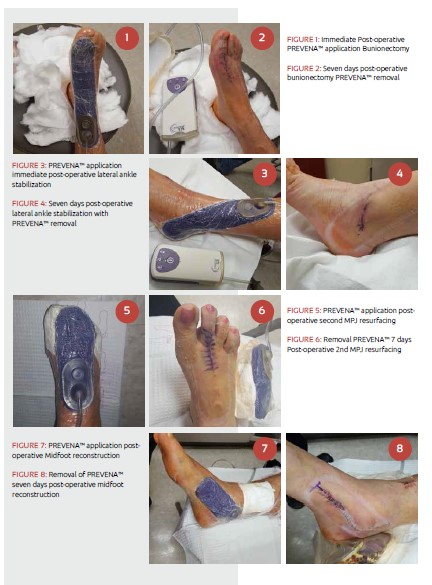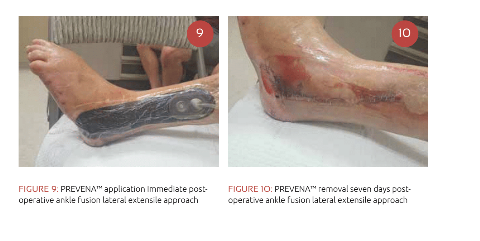
Dr. Philip Wrotslavsky is the Medical director of the Advanced Foot and Ankle Center of San Diego. He completed a limb lengthening fellowship at the International Center for Limb Lengthening in Baltimore MD. He his Board certified by the American College of Foot and Ankle Surgeons, His practice focuses on diabetic charcot foot and diabetic limb salvage. Dr. Wrotslavsky is a native of Brooklyn NY.
Wrotslavsky_The Chronicles of Incision Management_2017_Volume 1_Issue 2
INTRODUCTION
Postoperative pain management in lower extremity surgical cases historically have been mechanically managed with elevation, ice, compression and drains. Pharmacological management includes nerve blocks and analgesics. With the rise of the current opioid crisis, new methods are being sought to reduce post-operative pain so that patients are at lower risk for opioid addiction.
The peer-reviewed literature has shown that increased edema in the lower extremity leads to increased pain.¹ Post-operative edema control is vital to reduce tension on the incision since increased incisional tension may cause an increase in pain at the surgical site. Ice, elevation, compression and drains all can contribute to edema reduction, and thereby reduce pain and incisional tension.
The authors of this study want to introduce a new method that adds to pain control post-operatively in lower extremity surgery. By applying incisional negative pressure in the form of the PREVENA™ Incision Management System, the author has found a significant decrease in post-operative reporting of pain as well as a significant decrease in the use of narcotics in post-operative pain management.
BACKGROUND
The PREVENA™ Incision Management System is intended to manage the environment of surgical incisions that continue to drain following sutured or stapled closure by maintaining a closed environment and removing exudate via the application of negative pressure wound therapy.² However, no data has been collected regarding other benefits of the PREVENA™ Incision Management System on incisions. Microcirculation in the lower extremity has been reported to take over 72 hours to return to normal.³ Recommendations have been made to elevate the extremity for up to 5 days. Hematomas and seromas also play a large role in incision sites since they may cause a balloon effect. For example, just as too much air in a balloon will cause stretching of the balloon wall, so too for surgical incisions cause stretching of the entire area, which may result in edema and increased tension on the incision site. This ultimately can lead to increased pain..
It is of the author’s opinion that the use of the PREVENA™ Incision Management System reduces post-operative pain through multiple methods. First, the reduction of lateral tension on the incision edges with increased appositional strength and normalized stress distribution of the incisions reduces inflammatory markers and thus reduces pain. Second, the decrease in subcutaneous formation of hematoma and seroma causes less tension and thus less pain. Last, the increased lymph node clearance with the PREVENA™ Incision Management System use leads to decreased swelling, thereby also reducing pain.
METHODS
Fifteen sensate and opioid naive patients underwent various foot surgeries. Diabetics were not included due to the prevalence of neuropathy. For the post-operative dressing, either a PREVENA ™ PEEL & PLACE™ Incision Management System – 13cm or – 20 cm was placed on the incision. The unit was left on for 7 days in all patients. No surgical drains were necessary in these cases. Patients were interviewed at post-operative day 1, 3 and 7. All of the PREVENA™ Systems were removed on day 7. Patients were also interviewed on day 14 (at suture removal). Overall, there was a significant reduction of pain in these procedures than would normally be expected for similar foot and ankle surgeries as self-reported by the patients. As well, usage of opioids was reduced to less than one day on average per patient.
Anecdotal feedback from patients who had experienced previous surgeries (including foot surgeries) was that surgery with the use of the PREVENA™ Incision Management System was less painful. Two patients that needed an elective surgery on the other foot demanded use of the PREVENA™ Incision Management System in the contralateral foot as well. All patients reported an ‘ease-of-use’ dimension with the PREVENA™ Incision Management System that suggested no interference with usual daily activities of living, and that the surgeries they underwent were less painful than expected.
All patients reported an increase in swelling and pain the first three days after removal of the PREVENA™ Incision Management System unit. However, none needed to take opioids for the pain. The author observed this phenomenon and theorized that the surgical site would swell over the next 3 days as a rebound effect and that there would be a small increase in pain. All of the patients reported this at post op day 14 (one week after the removal of the PREVENA™ Therapy Unit). The author was careful to educate the patient around device removal and the potential for an increase in swelling. This patient education is important so they understand this swelling is normal.
CONCLUSIONS
The author has experience using the PREVENA™ Incision Management System in over 200 surgeries. His use has evolved from high-risk wounds to ‘regular’ risk elective surgeries. There are many reasons for this evolution. The author reports that, first, there is a reduction of surgical site infections as well as a reduction in incision closure time. The author also noticed that, over time, the author’s patients reported a significant reduction in pain over what is normally expected. There was also a reduction in usage of pain medicine and requests for pain medicine refills. The author started to utilize the PREVENA™ Incision Management System on lower-risk incisions more commonly in order not only to reduce SSI’s (surgical site infections) and closure time but as a potential approach to pain reduction. With the increased awareness surrounding opioid addiction, the author thinks the use of the PREVENA™ Incision Management System has the potential to play an important role in the improvement of public health and the reduction of opioid dependence as a byproduct of pain management.
While the basic biological pain response to incision healing and its release of local and systemic mediators cannot be stopped after an incision is made, there are factors that can be controlled in incision healing such as edema and bleeding. The use of the PREVENA™ Incision Management System in the author’s clinical experience has shown to reduce post-operative swelling and thereby reduce post-operative pain.
References
1.Attar, Fahad, et al. “Perioperative changes in the microcirculation in feet after foot and ankle surgery.” The Journal of foot and ankle surgery 46.4 (2007): 238-241.
2.Prevena Incision Management System, Application Instructions for Clinicians Only; page 5, KCI USA INC 12930 INTERSTATE 10 WEST, SAN ANTONIO, TX 78249
3.Attar, Fahad, et al. “Perioperative changes in the microcirculation in feet after foot and ankle surgery.” The Journal of foot and ankle surgery 46.4 (2007): 238-241.




